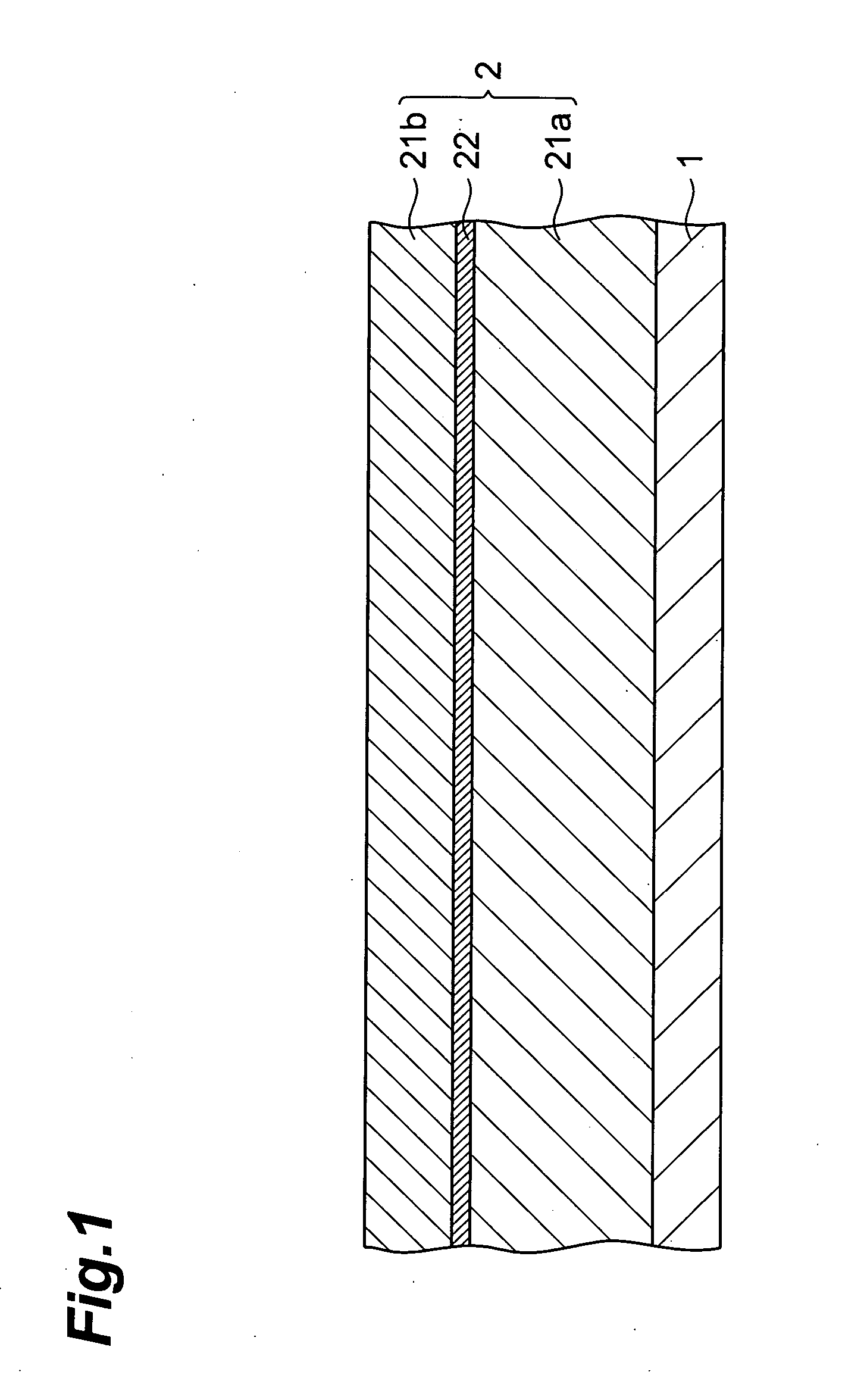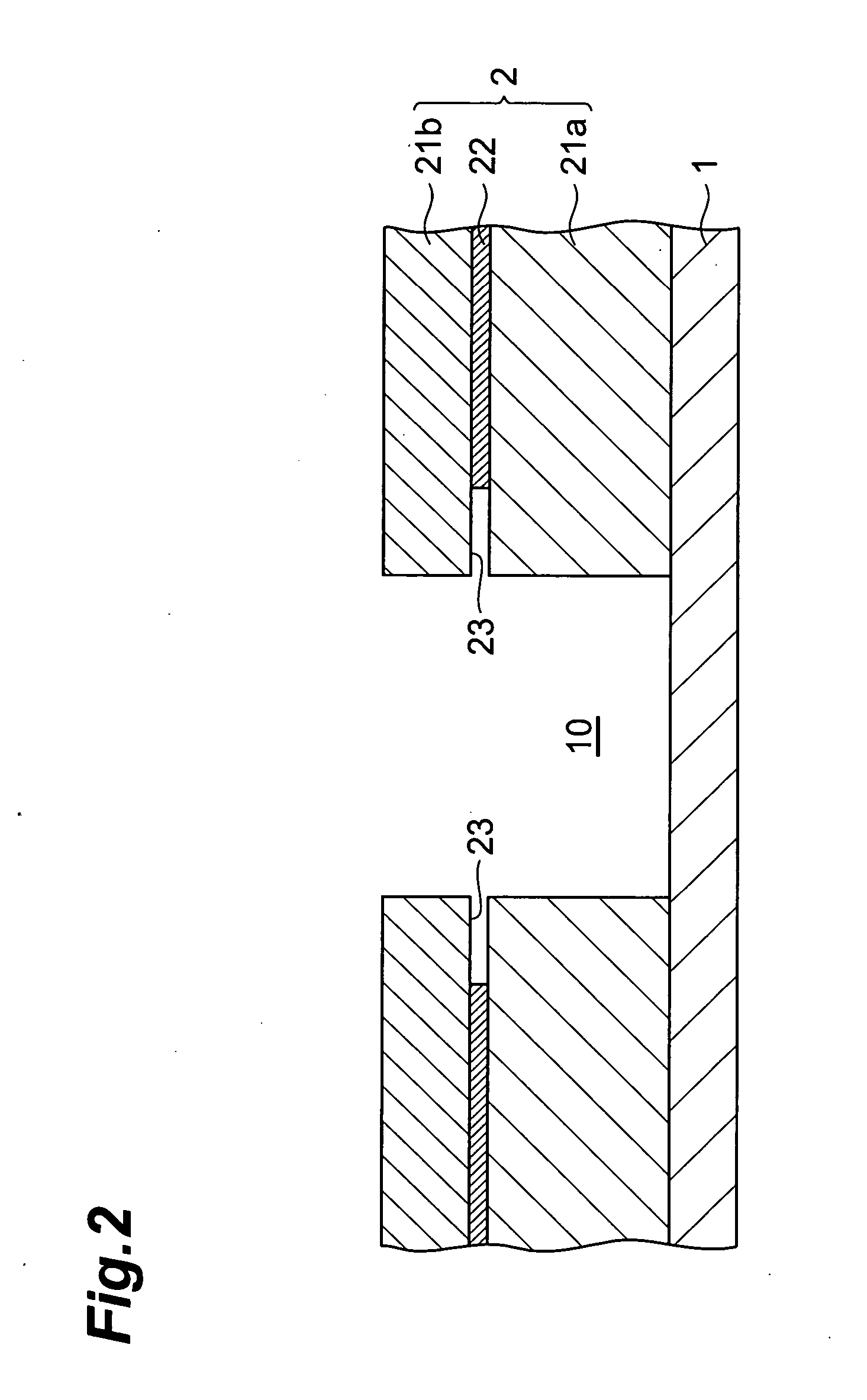Patterned material layer, method of forming the same, microdevice, and method of manufacturing the same
- Summary
- Abstract
- Description
- Claims
- Application Information
AI Technical Summary
Benefits of technology
Problems solved by technology
Method used
Image
Examples
first embodiment
[0032]FIGS. 1, 2, 3, and 4 are sectional views for explaining the first embodiment of the method of forming a patterned material layer in accordance with the present invention.
[0033] In the first embodiment, as shown in FIG. 1, a resist layer 2 having a three-layer structure in which a first photosensitive resin layer 21a, an intermediate resin layer 22 soluble in a developing solution after being exposed to light, and a second photosensitive resin layer 21b are laminated in this order is initially formed on a substrate 1 (resist layer forming step).
[0034] The material for the substrate 1 is appropriately chosen according to the use of the material layer formed and the like. Specifically, substrates made of Si, ceramics (Al2O3.TiC, etc.), polymer materials, and the like are used.
[0035] The first photosensitive resin layer 21a and second photosensitive resin layer 21b are formed by spin coating or the like using a photosensitive resin which becomes soluble in a developing solution...
second embodiment
[0045]FIGS. 5, 6, 7, 8, and 9 are sectional views for explaining a second embodiment of the method of forming a patterned material layer in accordance with the present invention.
[0046] First, a resist layer 2 is formed on a substrate 1 (FIG. 5) in the second embodiment as well. The substrate 1 is one in which a plating electrode film 12 is formed on a support 11. The support 11 is the same as the substrate 1 in the first embodiment. The plating electrode film 12 is formed when a material which can be used as a plating electrode (which is preferably the same material as that of a plating layer 4 to be formed later) such as conductive metal, ceramics, or organic matter is formed into a film by a method such as sputtering, CVD, vapor deposition, or electroless plating. Then, the resist layer 2 having the same three-layer structure as that of the first embodiment is formed on the plating electrode film 12.
[0047] Subsequently, by way of the same exposing step and developing step as tho...
third embodiment
[0050]FIGS. 11 and 12 are sectional views for explaining a third embodiment of the method of forming a patterned material layer in accordance with the present invention.
[0051]FIG. 11 is a sectional view showing a state after the vacuum coating step, where the vacuum coating layer 3 is formed. In the third embodiment, side faces of the first photosensitive resin layer 21a are tilted in the resist pattern (resist layer 2) formed with a trench. This can incline the side faces of the material layer made of the plating layer 4 and material pattern part 31 with respect to a main surface of the substrate 1. The side faces of the first photosensitive resin layer 21a can be tilted, for example, when the first photosensitive resin layer 21a cured upon exposure to light is heated to its glass transition temperature or higher so as to be fluidized. Employing a photosensitive resin less transparent to exposure light as the first photosensitive resin 21a can also tilt the side faces of the first...
PUM
 Login to View More
Login to View More Abstract
Description
Claims
Application Information
 Login to View More
Login to View More - R&D
- Intellectual Property
- Life Sciences
- Materials
- Tech Scout
- Unparalleled Data Quality
- Higher Quality Content
- 60% Fewer Hallucinations
Browse by: Latest US Patents, China's latest patents, Technical Efficacy Thesaurus, Application Domain, Technology Topic, Popular Technical Reports.
© 2025 PatSnap. All rights reserved.Legal|Privacy policy|Modern Slavery Act Transparency Statement|Sitemap|About US| Contact US: help@patsnap.com



